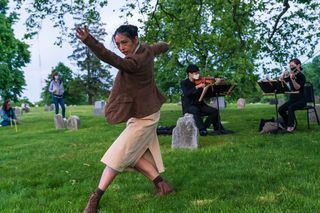|
Back
Hail and Farewell New York
Greenwood Cemetery
06/04/2021 - & June 5, 6 2021
“Hymn to the City”
James Weldon Johnson: My City
Aaron Copland/Shaker Songbook: Simple Gifts (arr. M. Kaufman)
Sergio Ortega: El pueblo unido jamás será vencido (arr. Lovato)
Leonard Bernstein: West Side Story Suite: “Maria”, “Tonight” & “I feel pretty” (arr. J. Gale)
Paul Simon: American Tune
Kinan Azmeh: Café Damas
Florence Price: String Quartet in G Major: II. Andante Moderato
Traditional Spiritual: Over My Head
George Gershwin/Adam Tendler: Cadenza on “Rhapsody in Blue”
Sarah Kirkland Snider: How Graceful Some Things Are, Falling Apart
Kevin Puts: Credo
Antonín Dvorák & William Arms Fisher: Goin’ Home (arr. Patrick Cannell)
James Henry (Narrator/compere), Liana Kleinman (Dancer)
Lucy Dhegrae (Mezzo-soprano), Paul Grosvenor (Baritone), Marcos Foster (Vocals and guitar), Adam Tendler (Pianist), Catalyst Quartet: Karla Donehew Perez, Abi Fayette (Violins), Paul Laraia (Viola), Karlos Rodriguez (Cello); Members of the New York Philharmonic Orchestra: Alison Fierst, Mindy Kaufman (Flutes), Richard Deane (Horn), Thomas Smith, Ethan Bensdorf (Trumpets), Colin Williams (Trombone), George Curran (Bass trombone),Dasol Leong, Kyung Ji Min, Jin Suk Yu, Qianquian Li, Na Sun (Violins), Leah Ferguson. Vivek Kamath (Violas), Alexi Yupanqui, Smire Kudo (Cellos)
Death of Classical (Producer)
“New York is the place where all the aspirations of the...world meet torm one vast master aspiration, as powerful as the suction of a steam dredge. It is the icing on the pie called...civilization.
H.L. Mencken, Prejudices (1927)
“In China there is a holiday around the death of your ancestors where everyone goes to the cemetery. It’s a celebratory thing. It’s very colorful.”
Filmmaker Lulu Wang (1983-)

L. Kleinman (© Steven Pisana)
The start of “Hymn to the City”, Andrew Ousley’s latest inspiration for Greenwood Ceremony, resembled a pilgrimage. Not the somber pilgrimage to Lourdes, or the ancient Buddhist pilgrimage to Mount Kailash. No, “Hymn to the City” was like Chaucer’s jolly Canterbury pilgrimage. To wit, a group of around 50 travelers, unknown to each other, entered under the phantasmagoric gates the Cemetery to pay homage...In this case Homage to New York. Not to martyrs, but those who survived the plague which visited the city last year.
Unlike Chaucer, no lyrical tales were told. Rather, as the group circled around Greewood, starting at dust, continuing through a night punctuated by the calls of African parrots, then the shadows of bats and the mating signals of fireflies, musicians bowed and blew, strummed and sung.
Chaucer would have praised them as master troubadours and minstrels. We more mundane folk would have heard a dozen-odd players from the New York Philharmonic Orchestra along with singers, a pianist and a dancer.
More about them later. First the conception. Mr. Ousley was looking for a production that paid tribute “to New York’s singular spirit of resilience and renewal after a year of collective trauma, loss and mourning.” An enclosed arena would be too constricting. Central Park would lack the plethora of stately monuments. Greenwood Cemetery, though, spread over 478 acres, with 600,000 graves and 7,000 trees, would have the potential to be both respectful, monumental and–with it gorgeous views of Manhattan–even pleasurable.

In the Catacombs (© Kevin Condon)
Thus we “pilgrims” were taken on special tour of Greenwood. From the “Theater Fire Monument”, where 19th Century First Responders lost their lives, to “Pilot’s Monument to “Battle Hill cenotaphs for Peace and Minerva, the Goddess of War. Then, the most surprising area, single graves with no inscriptions for the first immigrants.
(Was this a “Pauper’s Cemetery”? Well, Vienna’s pauper’s grave was good enough for Mozart!)
Finally a grand family mausoleum and the Catacombs for the final performance.
And around every landmark, consorts of artists played American music of the most varied. At the Leonard Bernstein family plot, a brass quintet played naturally) three songs from West Side Story. At another monument, two flutes, two violins and cello played the 19th Century Shaker song Simple Gifts and the unofficial South American anthem of the proletariat. (More on that later.)
A string quartet played a movement from Florence Price’s string quartet. The name was new to me, but Ms Price was the first African-American woman to have her music–a charming elegant work which could have been written by Antonín Dvorák. This was followed by a spiritual, also new to me, Over My Head.
Finally in the Catacombs (where, after miles and miles clambering over sward and cement, we could sit), Adam Tendler played his virtuosic riff on Rhapsody in Blue. Mezzo-soprano Lucy Dhegrae sung a stunning arrangement of Goin’ Home, the Dvorák theme. And most interesting of all, Kevin Puts’ Credo.
One caveat, and two adulations. The flutes/strings played Mindy Kaufman’s fine arrangement of the Copland-Shaker song. But when they tackled The People United Will Never Be Defeated, their sweet and elegant rendition was a sharp heel in the faces of millions people. The acidic power of the Chilean song–a combination of Marseillaise and Internationale–was diluted to a cup of dishwater. Those who had sung this–in Chile Bolivia, Argentina–were incarcerated and frequently murdered.
The audience clapped politely. I turned my back.
On the other hand, at the Hill of Graves, guitarist Marco Foster stood alone, played and sung Paul Simon’s American Tune. It was oh so moving. In the same spot, a trio of violin, viola and bass played the enigmatic Café Damas by Syrian-American Kinan Azmeh. Those notes were spellbinding by themselves. But the magic had only started. From far off came the shadow, then the figure, then the dance of Liana Kleinman. Hers were less dance, though and more apparition.
With the single singer, and a lone dancer, this Hymn to the City was transformed from a splendid conception to the spectral New York of Walt Whitman and Hart Crane.
Harry Rolnick
|